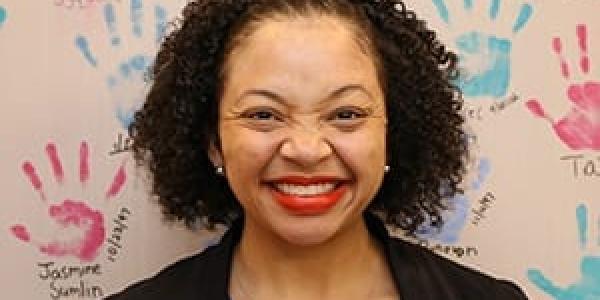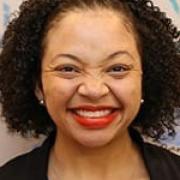From Our President. Children at the Center of it All! The Role of Children in a Strengths-Based, Play-Based Curriculum

You are here
“Pat-A-Cake, Pat-A-Cake”
“Boom Chicka Boom”
“Down by the River”
"Hide-and-Seek"
What are some of your earliest memories of early learning activities? Did they include play and joyful engagement? Did they center you, your strengths, and your lived experiences?
The songs and games above are from my early childhood years, when I enjoyed playing and singing along with family and friends. These songs and games not only included finger play and movement, but they also were opportunities to forge very early relationships with my peers, teachers, and family members within an engaging early childhood curriculum. The songs and games tapped into many developmental domains—physical, language, social and emotional, and identity development. These playful, joyful activities are still present today in early learning settings, including my children’s classrooms.
In this issue of Young Children, you have been introduced to various ways to plan and implement a curriculum that aligns with developmentally appropriate practice (DAP), which NAEYC defines as “methods that promote each child’s optimal development and learning through a strengths-based, play-based approach to joyful, engaged learning.” I ask you to pause and reflect on the role of children in any curriculum we implement so that it is play-based and strengths-based—it is DAP—each day.
To begin, let’s imagine that the children are the curriculum. I immediately think about how my 4-year-old son, Isaiah, enjoys all things monster trucks and race cars. His pre-K teacher, Ms. Alisha, values making home-to-school connections and building upon the cultural knowledge, experiences, and interests of the children she teaches—culturally relevant teaching in action!
For example, the program’s curriculum featured an activity about the concepts of sink and float. Through this activity, children were expected to learn about the density of objects by predicting and observing whether they would sink or float in water. Ms. Alisha began with circle time. She engaged children in oral storytelling about the objects they brought from home to test if they would sink or float. Isaiah proudly shared about his monster trucks and race cars. Ms. Alisha intentionally asked him questions, such as “Have you ever seen a real monster truck and race car before?” and “Does your family enjoy monster trucks and race cars?” Through this extended prompting, Isaiah’s story went beyond “This is my favorite monster truck, ThunderROARus, and the Dodge Charger here goes fast fast.” He shared his cultural story and family tradition of going to monster truck and race car events with his family—his mother, father, brother, sister, grandmother, uncles, aunts, and cousins. Similarly, Ms. Alisha enhanced the learning experience and connectivity for all of the children during this time.
In this example, the what of the curriculum was engaging children in the concepts of sink and float, but the how is most important: Ms. Alisha centered children by intentionally connecting to their real lives and their own cultural preferences, interests, and lived experiences. I know firsthand the impact of this learning experience on my son, as evidenced by Isaiah wanting to do sink-or-float activities each day after school and through all he told me about the items and stories his classmates and teachers shared.
As you reflect on Ms. Alisha’s intentional integration of children’s interests and experiences into the curriculum activity, ask yourself how you center children’s cultures, languages, and experiences when implementing the curriculum. Do you build upon the strengths and interests of children as the starting point when implementing your curriculum?
Now let’s explore children as the starting point of play-based, strengths-based experiences. In the sink-or-float activity, Ms. Alisha was intentional in making children the focus of the learning experience. Children should also be the center of all play experiences. There are many types of children’s play, and play is one of the key approaches to children’s learning and healthy development. Children should have ongoing opportunities to initiate and engage in play, and play should be centered on and for children. To do that for all children, learning environments and materials should reflect the voices, faces, experiences, and realities of the children in our settings. They also should reflect the diversity of our communities in terms of language, racial identity, cultural heritage, exceptionality, family dynamics, gender identity, and more.
Ask yourself how you promote play that is equitable, diverse, and child-centered. How do you provide spaces and materials for children to engage in dramatic play, play that is expressive, rough-and-tumble, uses movement and music, and includes artifacts from children’s homes, cultures, and communities? Have you asked families about the types of play children engage in at home? Does each child have the right to play from their individual, collective, and cultural lens and perspectives?
Lastly, let’s return to the framework of DAP. Part of DAP includes planning and implementing an engaging curriculum, observing and assessing children’s development, and creating a caring community of learners. These guidelines can only be accomplished if we really know the children we are teaching—like Ms. Alisha, who learned about each child’s interests and background and used that information to guide children’s understanding of science concepts.
Ask yourself how you learn about children to address the guidelines of DAP. Do you know the daily routines of each child once they leave your classroom or program? Do you know each child’s preferences for play, their unique talents, interests, or gifts? Do you know their language and cultural practices? Do you see each child as a capable and valued member of your community of learners? Do you often reflect on any biases that you have against or for each child?
Part of DAP includes planning and implementing an engaging curriculum, observing and assessing children’s development, and creating a caring community of learners. These guidelines can only be accomplished if we really know the children we are teaching.
All of the questions I have posed can help provide information we can use to implement a curriculum that is strengths-based and play-based—that is DAP—every day. I encourage us all to center children in our work so that we can be even better at providing high-quality, equitable, and culturally responsive experiences for all of them. The good work we each do for children, families, and the early childhood community continues. So upward and onward with our charge and mission of providing high-quality learning for young children!
Copyright © 2025 by the National Association for the Education of Young Children. See Permissions and Reprints online at NAEYC.org/resources/permissions.
Tonia R. Durden is president of the National Association for the Education of Young Children.
